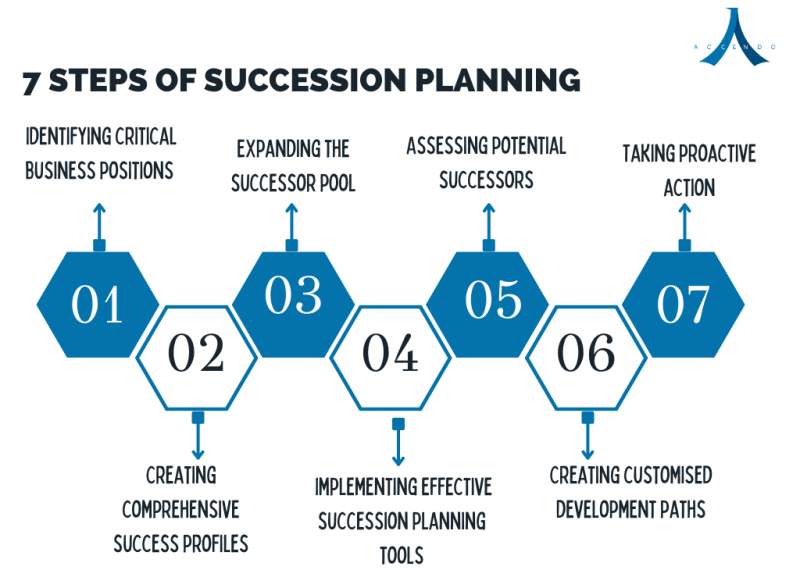
Succession planning is critical for organisations to ensure smooth leadership transitions and long-term success. In our comprehensive guide, we explore why succession planning is important, the challenges of succession planning, and the strategies required to overcome them. Our succession planning guide also covers the four-step process, implementation steps, benefits, real examples, best practices, and emerging trends. With this guide, developing a succession plan will become second nature to you.
Introduction
In the dynamic realm of business, a strong and adaptable leadership team is the catalyst for extraordinary success. But what happens when a key leader departs, leaving a void in your organisation’s future? Prepare to embark on an exhilarating journey as we unveil the transformative secrets of succession planning. From nurturing the brightest talent to cultivating a seamless transition strategy, this guide empowers you to forge an unstoppable legacy and embrace the winds of change with confidence. Are you ready to unleash the full potential of your organisation? Let’s dive in!
According to ATD’s research report, only 35% of organisations have a formalised succession planning process for critical roles.
That is why it is essential to have a succession plan in place. Our guide aims to help you avoid the pitfalls and ensure your success rate is higher than the reported 35%. Let us dive deeper into the topic and find out what you need to know.
What is Succession Planning?
There is an old saying that goes like this, “If you fail to plan, you plan to fail.”
Sure, it can be hard to consider what might happen to your company when your business is comfortably chugging along, or when the economy and your financial future look secure, or when a leader suddenly leaves. After all, you cannot anticipate when something happens; but you can prepare for what needs to be addressed should a big change in leadership comes along.
Succession planning is the strategy you need to identify and nurture internal talent for these critical roles. It goes beyond simply replacing outgoing leaders; it focuses on developing individuals who possess the necessary skills, knowledge, and experience to drive the organisation forward.
Why is Succession Planning Important?
According to Paul Glatzhofer, VP of Talent Solutions, organisations who struggle with succession planning often fall into one of these categories:
- They do not do any succession planning
- They make it so complex that no one wants to engage in the succession planning process
- They are focusing on the wrong type of data
Succession planning is important to ensure your organisation always has the right leaders in place should a change happen quickly. By failing to create an orderly plan for succession, your company may not get a second chance. Here is our another detailed blog on Why is Succession Planning Important?
Harvard Business Review pointed out that the market value wiped out by poorly managed CEO and C-suite transitions in the S&P 1500 alone is close to $1 trillion a year.
What are the Challenges of Succession Planning?
While succession planning offers numerous benefits, organisations often face several challenges during the process. Some common challenges include:
Fragmented data collection and analysis
Organisations often collect data in a fragmented manner, overlooking valuable information like psychometric test results. Inadequate analysis hinders objective evaluation of potential successors, leading to reliance on past performance rather than future potential. This can contribute to the Peter Principle, where candidates are selected based on past roles rather than future capabilities.
Successor readiness and development
Ensuring that potential successors are adequately prepared for their future roles is crucial. This requires investing in their development through training, mentoring, and providing growth opportunities.
Bias and subjectivity while identifying successors
Finding individuals who possess the right skills, knowledge, and potential to step into leadership roles can be a challenge. However, this process is often influenced by a manager’s perception and unconscious biases. These biases can result from a lack of qualitative, holistic data and can hinder the objective evaluation of potential successors.
Research conducted by Deloitte reveals that 86% of companies with strong succession planning outperform their competitors.
Assuming success in lower positions guarantees success in higher positions
A common mistake is assuming that high performers in one level will effortlessly thrive in higher-level positions. Continued success is not a guarantee. Relying solely on past performance is inadequate. Instead, the focus should be on selecting or developing individuals based on their suitability for the distinct challenges and demands of higher-level positions.
Poor mapping of goals to skills
Succession planning becomes more complex when your organisation has specialised roles or technical expertise. These roles may require new sets of competencies and skills. Identifying individuals with the necessary skills and knowledge to fill these roles requires well-carved-out competency models, proactive talent development, and strategic workforce planning.
The Seven Steps in a Succession Planning Process
The succession planning process varies for each organisation based on its own talent requirements and business needs. If you are working on developing a succession plan for your company, you can start with these steps and form a plan that best aligns with your organisation’s objectives.

Step 1: Identifying critical business positions
Identifying key business positions is crucial for organisational continuity and success. These positions hold significant responsibilities that cannot be left vacant for extended periods or are challenging to fill. Recognising these roles allows you to prioritise your succession planning efforts and ensure a seamless transition when needed.
Step 2: Creating comprehensive success profiles
To build effective success profiles, you must identify the behavioural requirements specific to each role. This involves understanding the skills, knowledge, and attributes necessary for success in those positions. By mapping these key competencies, you can create clear guidelines for evaluating potential successors, making the evaluation process more streamlined, objective, efficient, and effective.
Step 3: Expanding the successor pool
A successful succession planning process extends beyond senior management. It is important to look across departments, positions, and teams to identify individuals who possess the potential to become future leaders. By considering a diverse pool of candidates, you can tap into a wider talent pool and ensure a robust succession pipeline.
Step 4: Implementing effective succession planning tools
Implementing the right tools and systems, such as Accendo’s Succession Planning solution, is crucial to support the succession planning process. With its ability to assess and benchmark candidates based on leadership, agility, culture, and technical scores against validated success profiles, our solution enhances the effectiveness of your succession planning efforts.
Step 5: Assessing potential successors
Evaluating potential successors is critical as you need to assess candidates’ readiness, capabilities, and potential for taking on new roles. This may involve a combination of assessment tools which are found on our Assessment Marketplace, such as 360 feedback, business simulations, cognitive assessments, functional and technical assessments, and psychometric tests to gain an in-depth understanding of each candidate’s suitability for future leadership positions.
A survey conducted by the Society for Human Resources Management (SHRM) that 65% of organisations with a formal succession plan experienced smoother leadership transitions and reduced disruption.
Step 6: Creating customised development paths
Not every candidate is ready to step into a leadership role immediately. You must develop customised development plans for each potential successor, providing them with the necessary support, training, and experiences to enhance their skills and prepare them for future responsibilities. These personalised development paths help nurture and guide individuals on their journey towards leadership positions.
Step 7: Taking proactive action
Implementing the succession planning process early on, even during the hiring phase, allows you to proactively prepare for future leadership needs. Succession planning is a continuous and long-term process, often taking months or even years. By being prepared and taking proactive action, you can avoid disruptions and ensure a smooth transition when the need arises.

A Succession Planning Model for HR
A succession planning model for HR is a framework that your HR teams can use to effectively manage and implement succession planning initiatives within an organisation. There are various models available, but one commonly used model is the “9-Box Grid” or “9-Box Model.”
The 9-Box Grid serves as a powerful succession planning model by:
- Providing a visual representation of the talent pool based on performance and potential.
- Prioritising succession planning efforts by focusing on specific grid positions.
With performance on the X-axis and potential on the Y-axis, this model helps identify high-potential individuals ready for growth and advancement, while also highlighting areas for improvement and support. Your HR teams can then devise targeted strategies such as tailored development programs or external recruitment, to address these gaps effectively.
How to use the 9-Box Grid to Improve Succession Planning
The 9-box Grid is a valuable tool for managers in succession planning. It helps to assess team members’ performance potential, identifying high-performing individuals with potential for promotion. Engaging these top performers through challenges, recognition, and rewards is crucial for their continued growth and motivation.
In a study by Harvard Business Review, it was found that companies with a strong succession planning process are 2.5 times more likely to be considered “high performing” by their peers.

To effectively utilise the 9-box Grid for succession planning, follow these steps:
Set up your grid
Create a three-by-three grid on paper or using a computer program – the X-axis represents different measures for performance (such as productivity, leadership, or teamwork) and the Y-axis represents the levels by potential (such as low, moderate, or high).
Assign your team members to boxes
Evaluate each team member’s potential and performance, considering factors such as their current abilities, growth potential, and readiness for advancement. Assign them to the appropriate box based on this assessment.
Create action plans for each member
Use the positions of team members in the matrix to create tailored action plans for each employee. For example, those with “Moderate performance, high potential” can be earmarked for promotions and provided with targeted training or mentorship to enhance their skills and readiness for leadership roles.
Enhance performance and potential
Implement the action plans developed for each team member to maximize their potential and improve their performance. Offer development opportunities such as training programs, stretch assignments, or coaching. Provide the necessary support and resources for their growth and track their progress over time.
Review and revise the grid as needed
Regularly reviewing and updating the 9-Box Grid is crucial to ensure its relevance and effectiveness in succession planning. As performance and potential can change over time, it is essential to periodically reassess team members and adjust their positions on the grid.
The Benefits of Succession Planning
A Gartner survey revealed that more than a third of HR leaders struggle with developing effective senior and mid-level leaders, with only 50% feeling prepared to lead their organisations in the future.
At the same time, research by Harvard Business Review found that unsuitable CEO or C-suite hires can reduce market value by USD 1 trillion annually, while the right leaders in these positions can improve a company’s valuation by 20% to 25%. While these findings highlight the importance of a well-formulated succession plan, here are five reasons why you must have a succession plan for your organisation:
Retention and engagement
Incorporating growth and development opportunities through succession planning increases employee satisfaction, engagement, and loyalty. When employees see a clear pathway for advancement, they are more likely to stay committed, motivated, and actively contribute to its success.
Leadership development
Succession planning serves as a platform for identifying and nurturing future leaders. By providing targeted development opportunities, organisations can groom individuals to assume leadership roles with the necessary skills, knowledge, and experience, thus ensuring a strong leadership pipeline.
Improved organisational performance
Effective leadership succession planning contributes to an improved workforce, leading to enhanced organisational performance. By nurturing and preparing your employees for leadership positions, you can build a skilled and capable talent pool. This translates into smoother transitions, seamless decision-making, and the ability to adapt quickly to changing market conditions or internal challenges.
Positive organisational culture
Succession planning fosters a culture of learning, development, and career growth within your company. This, in turn, enhances employee morale, motivation, and commitment. Employees perceive your organisation as invested in their professional growth, which cultivates a positive work environment and promotes employee satisfaction.
Continuity and stability
Succession planning ensures a smooth transition of leadership, minimising disruptions and maintaining organisational stability. By having a clear plan in place, you can mitigate the risks associated with sudden leadership changes, ensuring that operations continue seamlessly, and strategic goals are not compromised.
How Top Companies Manage Succession Planning
Several prominent organisations have implemented successful succession planning programs, including:
Apple
Apple prioritises strategic leadership succession planning to facilitate smooth leadership transitions and preserve its innovative culture. The company strategically plans for succession by nurturing internal talent, identifying future leaders, and balancing continuity with fresh perspectives. This approach ensures a strong leadership bench and a sustainable future for the company’s innovative culture.
General Electric (GE)
GE is known for its robust leadership development and corporate succession planning initiatives. The company places a strong emphasis on identifying and developing potential leaders early on, providing them with diverse experiences and comprehensive training programs.
IBM
IBM has a comprehensive corporate succession planning program that focuses on identifying and developing high-potential employees. The company provides targeted development plans, mentoring relationships, and exposure to cross-functional experiences to prepare potential successors for leadership roles.
Procter & Gamble (P&G)
P&G is renowned for its talent development and succession planning practices. The company actively identifies and grooms future leaders through structured programs, including job rotations, mentoring, and executive education opportunities.
Best Practices in Succession Planning
To optimise the succession planning process, organisations should follow these best practices:
- Align succession planning with strategic goals: Ensure that succession planning efforts are closely aligned with your organisation’s strategic objectives and long-term vision.
- Foster a culture of development: Promote a learning culture that emphasises continuous development and career growth opportunities for all employees.
- Regularly review and update succession plans: Continuously evaluate and update succession plans to adapt to changing business needs, emerging talent, and leadership requirements.
- Encourage diversity and inclusion: Embrace diversity in succession planning efforts by considering candidates from different backgrounds, experiences, and perspectives to foster innovation and avoid biases.
- Develop communication and transparency: Communicate the purpose and benefits of succession planning to all stakeholders, creating a transparent and inclusive process.
- Continuously evaluate the effectiveness: Regularly assess the impact and effectiveness of the succession planning program through metrics, feedback, and reviews to drive continuous improvement.
Click here for our best practices in selecting the right tools to help your process.
Global Trends Influencing Succession Planning
The field of succession planning continues to evolve, and organisations should stay aware of emerging trends, including:
- Succession planning in a remote work environment: With the rise of remote work and virtual teams, organisations need to adapt their succession planning practices to identify and develop leaders who can effectively lead in a remote or hybrid work environment.
- Focus on digital leadership capabilities: The increasing importance of digital transformation calls for leaders with strong digital acumen and the ability to navigate technological advancements. Succession planning should prioritise the development of digital leadership competencies.
- Data-driven succession planning: Utilising predictive analytics to identify high-potential employees, assess performance, and make informed decisions regarding succession planning.
- Agile succession planning: Embracing an agile approach to succession planning to ensure organisations can quickly respond to changing market dynamics and unexpected leadership vacancies.
- Diversity and inclusion in succession planning: Emphasising the importance of diversity and inclusion in succession planning efforts to foster a broader range of leadership perspectives and drive innovation.
Key Takeaways
Here are some key takeaways from our blog:
- “According to a survey conducted by PwC, 55% of CEOs worldwide are concerned about the potential skills shortage and lack of successors to key leadership positions within their organisation.” This statistic reveals the growing apprehension among business leaders regarding the availability of qualified individuals to fill critical roles in the future. It emphasises the urgency for organisations to proactively implement succession planning strategies to identify and develop the next generation of leaders.
- Practising proactive succession planning can help to mitigate talent gaps, ensure continuity, as well as foster smooth leadership transitions and long-term success. Accendo’s Succession Planning solution helps you create a robust succession plan by assessing and benchmarking your candidates based on leadership, agility, culture, and technical scores against our globally validated success profiles.

Frequently Asked Questions (FAQs)
Why succession planning is important?
Succession planning is crucial as it ensures a seamless transition of leadership, mitigates risks associated with key personnel departures, and maintains organisational stability. It identifies and develops future leaders, preserving institutional knowledge, and facilitating the transfer of critical skills. It is a proactive approach that minimises disruptions, fosters continuity, and strengthens organisational resilience and supports long-term success.
What are 4 stages of succession planning?
The four stages of succession planning typically include the identification of key roles, assessing potential candidates, developing their skills, and implementing the transition process.
What is more essential for succession planning?
Succession planning entails identifying and developing talented individuals for leadership roles, transferring critical knowledge, and ensuring smooth transitions. Assessing potential, providing training and mentoring, and establishing knowledge-sharing initiatives groom successors. This preparation ensures continuity and meets future leadership needs.
Who should be responsible for succession planning?
Succession planning is a joint responsibility shared by senior leadership and the HR department. Senior leaders define the organisational vision and identify key positions and potential successors, while HR facilitates talent assessment, development, and knowledge transfer.
Which model is most commonly used in succession planning?
The most commonly used model in succession planning is the nine-box grid, which assesses employees based on performance and potential to identify high-potential candidates.
How long does succession planning take?
The duration of succession planning can vary depending on the size and complexity of the organisation, as well as the specific goals and requirements. An effective succession plan may take several months or even years to develop, implement, and refine to ensure a seamless transition of leadership roles.
Which critical roles need succession planning?
Succession planning should focus on critical roles, such as senior executives, key management positions, and specialised roles that are crucial for business continuity.
What is the role of HR in succession planning?
HR plays a vital role in succession planning by identifying high-potential talent, facilitating leadership development programs, providing guidance, and ensuring fairness and transparency throughout the process.
Page Contents






